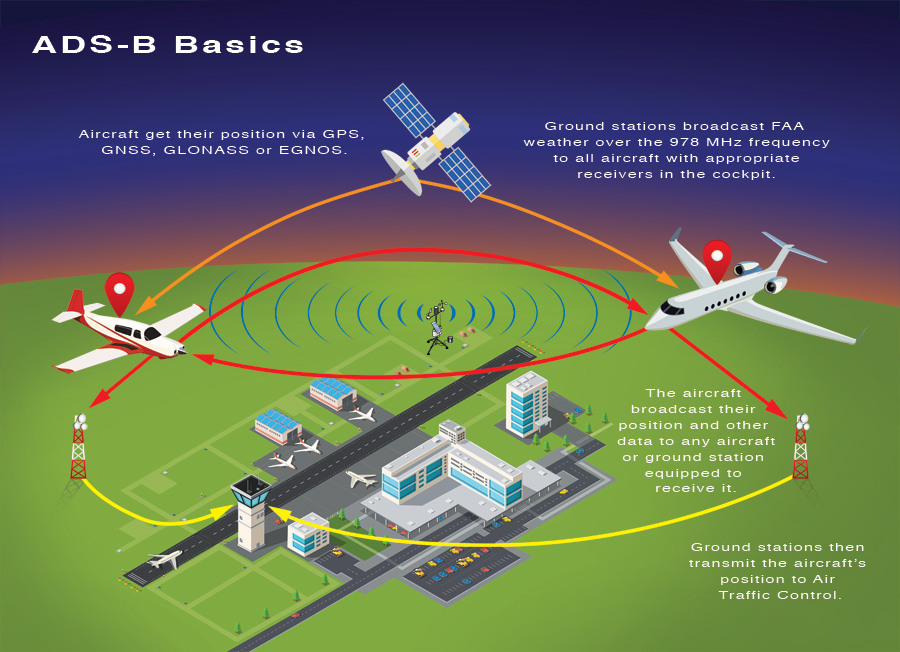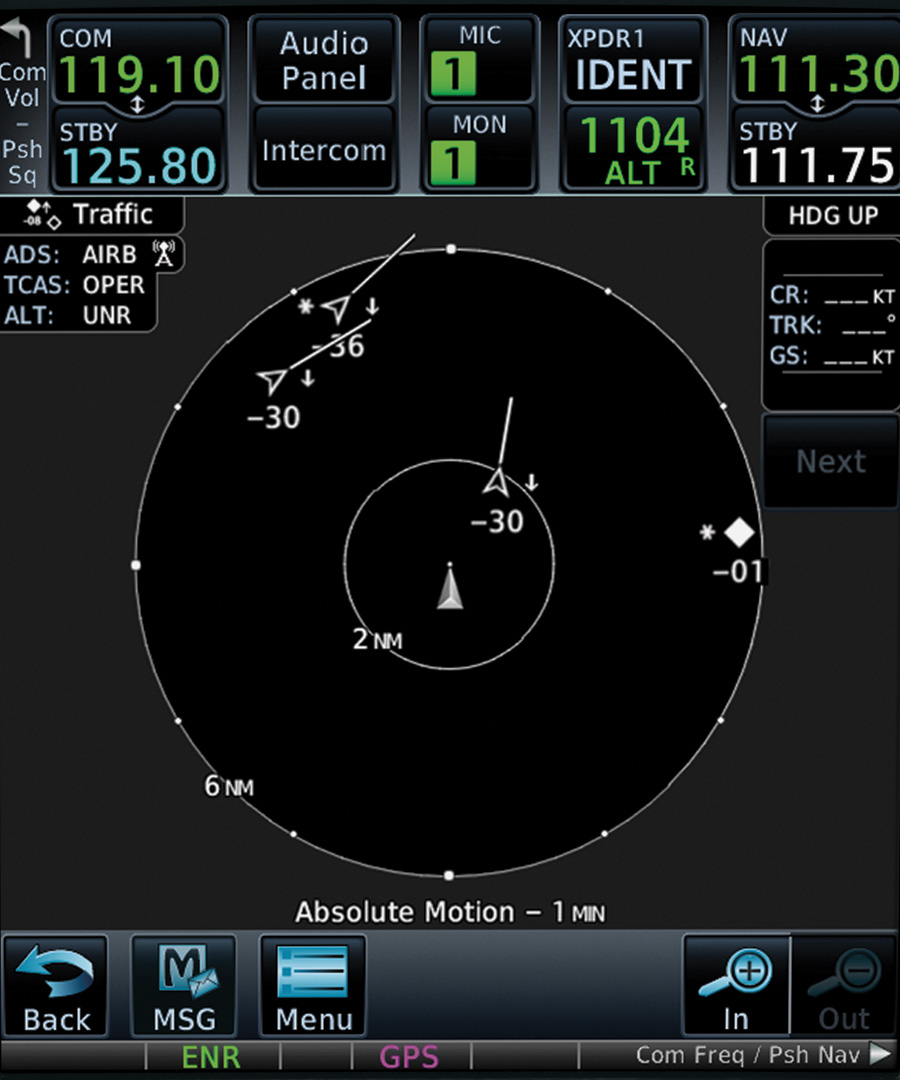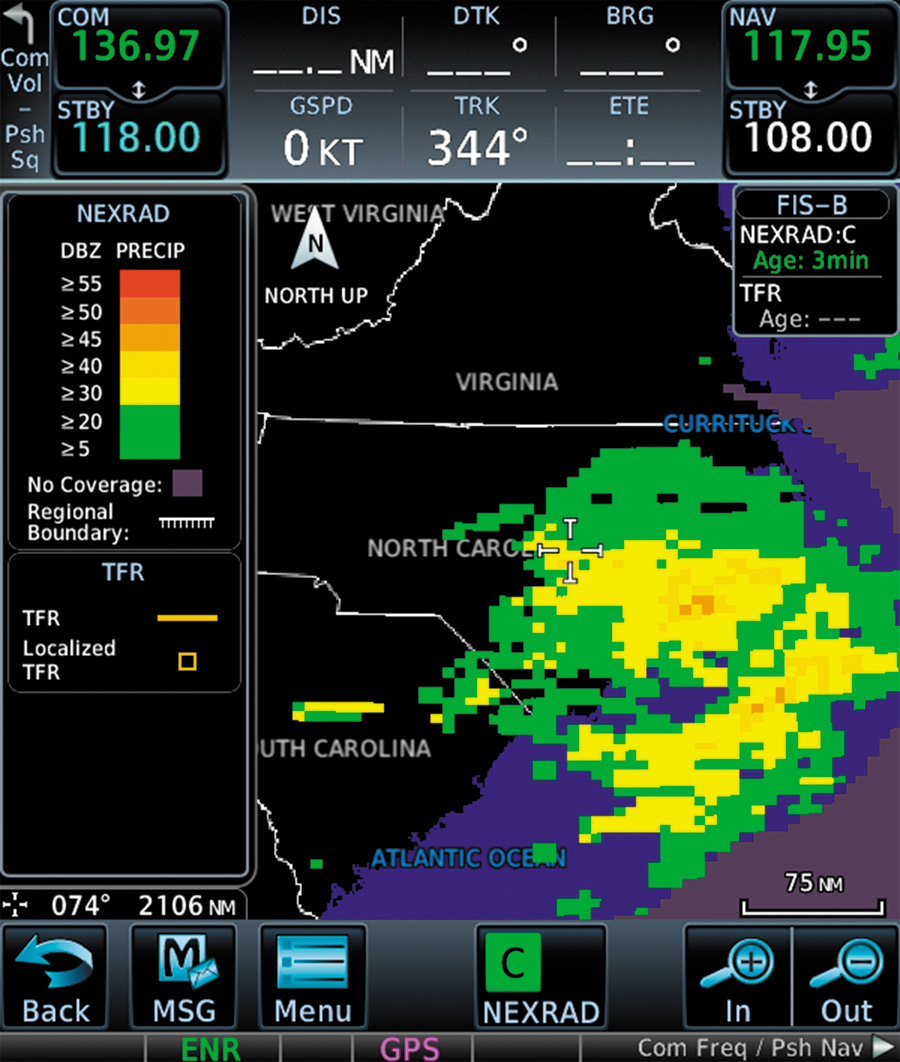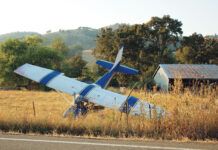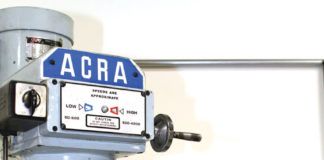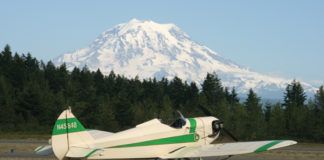By now you are certainly aware of ADS-B, the acronym for Automatic Dependent Surveillance—Broadcast. But how does it really affect you? Here is a mission-oriented decision process for dealing with the FAA’s 2020 deadline for becoming ADS-B Out compliant. I will also discuss the optional ADS-B In configuration.
You are faced with one mandate, two frequencies, two transmission directions, two services, several categories of equipment, and multiple vendors! The situation may seem chaotic, but can be broken down into manageable elements. Understand your goals and options before shelling out those bucks. It is a juggling act.
This article assumes a basic knowledge of ADS-B and the FAA’s mandate. If you are not comfortable with your knowledge of ADS-B, there are useful ADS-B tutorials on the Internet (see sidebar below). It is critical to keep in mind the differences between the ES (extended squitter) function and the transponder function. Remember, a transponder is still required after 2019 in transponder airspace.
This article is focused on Experimentals. Certified aircraft will follow the same decision logic except you must install TSO’d equipment, and it must be installed by a certified avionics repairman or shop. ELSAs and SLSAs will also follow the same decision logic, but what can be installed and who can do it are complex. It is best to consult with the manufacturer and the aircraft operating limitations of the airworthiness certificate.
I capitalized “Weather” and “Traffic” to specifically refer to the FAA’s ADS-B In products. I do not discuss specific vendor hardware.
The Long View
We have been blessed with an enormous amount of freedom to fly in this country. Occasionally we must conform to new norms for the overall good. NextGen, of which ADS-B is part, is the FAA’s master plan. It is a major evolution of the U.S. air traffic control system.
ADS-B Out’s part is to provide more frequent and accurate three-dimensional position information than is possible with Mode C or radar. ADS-B Out is the cornerstone of many of the improvements that the FAA wants to make. If we want to continue using the airspace where the big boys play, we have to equip up.
The ability to see traffic and weather is the carrot to get pilots to upgrade to ADS-B. If you only adopt ADS-B Out, you miss out on these capabilities.
The ADS-B Out mandate is controversial because of the costs and lack of benefits to aircraft owners of ADS-B Out by itself over Mode C. However, ADS-B is also an opportunity because the FAA is offering Weather and Traffic on a subscription-free basis. The cost of ADS-B Out is really the price for continuing to use parts of the airspace system after 2019. You or a subsequent buyer will have to pay to use that airspace sooner or later. Your only alternatives are to restrict the areas of usage or park your aircraft.
I have been flying the whole ADS-B Out and In configuration for a year. For my missions, I can no longer imagine flying without Weather or Traffic. I believe Weather and Traffic will become essentials in a large portion of the general aviation fleet, like GPS. Some benefits have to be lived to be appreciated. Fortunately, there are enough installs showing up around airports that you can find an implementation to examine firsthand.
What is Your ADS-B Out Mission?
This is a question of where do you fly, which defines the frequencies you can use. ADS-B Out does not enable you to fly anywhere you can’t go with Mode C. It just allows you to go there after 2019. The transponder-required airspace rules are the same as current rules.
Flying in the U.S. above 18,000 feet, a 1090 MHz ES solution is required. Below 18,000 feet in the U.S., 1090 MHz or 978 MHz can be used. If your aircraft has flight-level performance, it should logically be 1090 MHz equipped, regardless of the altitudes you typically use.
Basically, 978 MHz Out is a niche product. Using 978 Out only makes sense for limited aircraft in limited categories that never fly the flight levels or internationally. Things like LSAs, helicopters, flight schools, ag operations, acrobatics, etc. could be candidates. While 978 MHz Out satisfies the ES requirement, it still has to be paired with a 1090 MHz transponder.
When in doubt go 1090 MHz. Currently there are almost three 1090 MHz ES units installed for every 978 MHz Out unit installed. The U.S. adopted 978 MHz Out to decrease frequency congestion on 1090 MHz and to get bandwidth for Weather.
Internationally, most countries have not yet mandated ADS-B Out. They are expected to over an extended period. This is a country-by-country decision. Those countries adopting often seem to be using ADS-B as a substitute for radar where aviation radar is sparse or non-existent. Those countries that have implemented some form of ADS-B have not offered the 978 MHz option nor are many, if any, expected to.
Canada currently has no plans to require ADS-B Out, but they do provide some ADS-B In Traffic services to 1090 MHz ES equipped aircraft. Mexico and the Caribbean countries have not decided on anything yet. Australia does require 1090 MHz Out in many cases. Europe is a patchwork of requirements. International resale opportunities will be impacted if you have installed 978 MHz Out, rather than 1090 MHz Out.
By 2020 you must make an ADS-B Out decision, even if it is to do nothing. If you pass, you will be restricted to non-transponder-required airspace.

What is Your ADS-B In Mission?
The ADS-B In mission is a question of how you value cockpit Weather and Traffic. Those are the incentives that the FAA hopes will ease the pain of the mandated ADS-B Out equipment. ADS-B In could be available at relatively small additional cost, depending on what equipment you may already own.
If you are budget limited, you can do an ADS-B Out solution only. You can still do ADS-B In the legacy way: Get preflight weather briefs and in-flight weather. Get traffic by scanning and listening to the radio.
What are the Considerations Around Weather?
Cockpit weather is especially valuable when flying cross-country. Changing conditions can be monitored in route. It is much quicker and convenient than trying to get updates over the radio. Weather does not require ADS-B Out as it is continuously broadcast to everyone.
There are many tablet and portable weather solutions. Not all vendors display the same weather products/content, although there seems a common core. Real-time notification of TFRs is very helpful because of their pop-up nature. Particularly with weather graphics, you need to know the delays inherent in their transmission.
The FAA’s digital Weather (as distinguished from graphic products) is broadcast for locations only within a fixed radius of ground stations. The distance depends on the ground station power class. Therefore, long flights should still be conventionally briefed. XM weather is more flexible in that aspect. However, XM weather is delivered via geosynchronous satellite, so it is restricted to the contiguous 48 states and lower-latitude Alaska and Canada because of low satellite look angles. XM also covers ocean regions because of how it is delivered.
The FAA’s weather is free, while other sources like XM are not. It has been said that the FAA has 80% of the functionality of XM weather, but at 100% less cost!
If you fly internationally, you will need to get a different weather service as 978 MHz weather is U.S. only. There is no Weather on 1090 MHz by international design. If you fly over 24,000 feet, you will also need a different weather solution as that is listed as the transmission height of 978 MHz.
What are the Considerations Around Traffic?
Traffic is most valuable when you fly in busy airspace, in non-towered airport environments, and where some entity does not maintain separation. The universal response of people who have installed Traffic is that they didn’t know there were so many aircraft out there. The FAA says Traffic is a “traffic awareness” system. It is not a TCAS (Traffic Alert and Collision Avoidance System) and cannot be configured as one. It does not command or require conflicting aircraft to maneuver.
Traffic is the unique offering of ADS-B (see sidebar, items 9-11). Only with ADS-B Out installed can you be deemed a “valid client” and receive the most complete, but still not perfect, Traffic picture.
It is critical to understand the nuances of Traffic in order to understand how to select ADS-B In equipment and its limitations in use. This isn’t easy! It takes the parsing skill of a lawyer to keep things straight.
If out of ground station coverage, air-to-air reception of another aircraft’s ES Out transmission is how you receive traffic. This means needing ADS-B In receivers for both bands (978 MHz and 1090 MHz) if you are in the U.S. below 18,000 feet where both bands are in use. Internationally you will need a 1090 MHz receiver. Out of ground station coverage means no ADS-R or TIS-B.
If in ground station coverage in the U.S. and a “valid client” (that is an ES emitter), you will receive air-to-air traffic plus ADS-R and TIS-B for your “hockey puck” (see sidebar, item 9). ADS-B In equipped aircraft that are not ADS-B Out can overhear the ground station transmissions, but cannot know if they are receiving all traffic centered on their location. Since a ground station may be broadcasting for multiple “valid clients” at the same time, your software selects what belongs in your “hockey puck.”
ADS-R is a “bent pipe” that rebroadcasts ES Out signals with frequency translation. It converts 978 MHz to 1090 MHz and vice versa. This means that a single-band ADS-B In receiver will receive the other band’s ADS-B Out traffic. You need to be below 24,000 feet for 978 MHz receivers. That is the service height of 978 MHz ground station transmissions. In case you are receiving both air-to-air and ADS-R, the strongest signal wins.
TIS-B is targets from the FAA’s radar systems. These are primarily Mode A/C transponder targets. Except for some terminal and airport surface areas, TIS-B does not include primary (skin paint) targets. Over time, as aircraft install ADS-B Out, TIS-B provided targets will decrease.
Traffic has some significant limitations because of terrain shadowing, radar coverage limitations, and ground station location. Critically, even if you are within ground station and radar coverage, you might not be below your altitude. Therefore, be especially wary below you. To give you a feel for the issue, I advise asking at your home airport the height above ground that they receive ground station transmissions and separately radar coverage. Plainly this changes at other airports. It is unclear why the FAA does not provide that information in the Airport/Facilities Directories.
The best, but still not perfect, Traffic picture is obtained with dual ADS-B In receivers and to be within ground station and radar coverage. The Traffic picture will still potentially be incomplete because of the non-transponder/non- ADS-B Out traffic that will still be present after 2019. Most common among these are ultralights, balloons, gliders, and aircraft certified without electrical systems. It is anticipated some form of upcoming UAS (drone) awareness will come through ADS-B In. FAA Traffic isn’t perfect but it is better than solely relying on see and avoid.
It does not appear that the normal bottom mounting of receiver antennas has been an issue with air-to-air reception. Therefore, it doesn’t appear that antenna diversity (needing antennas on the top and bottom) is needed.
With Traffic, the vendor’s output screen design, target selectivity, and logic are critical. Screens need to be adjustable to reduce clutter or non-relevant targets. You need to be able to quickly focus, recognize threats, and respond appropriately. These are “head down” functions. You are your own non-automated traffic conflict resolution officer.
What are the Ground Station Issues?
There are gaps in ground station coverage particularly west of the Rockies and in Alaska. The gaps decrease with altitude like VORs, but in some places not totally eliminated.
When outside of ground station coverage, you will miss Weather and the Traffic that would be uplinked through ADS-R and TIS-B. No Weather or ground station transmitted Traffic is available over ocean areas except close to the coastal perimeter. There are some ADS-B ground stations on oil platforms in the western Gulf of Mexico.
What is Your Ownership Time Horizon and When Should You Install?
If you are not transponder equipped now, don’t need ADS-B In Traffic services, and are happy with the airspace restrictions, do nothing. Nor do you need to finish reading this article!
A key factor is how long you intend to own your aircraft. If you are selling before the mandate goes into effect, and you don’t need the ADS-B In benefits now, do nothing. Let the buyer deal with the problem in light of his missions. If a buyer can’t get his preferred solution installed promptly, that may impact salability. Typically costs of upgrades are not fully recovered upon resale.
If you intend to keep your aircraft and have no ADS-B In needs now, then install an ES solution at the latest minute, considering the time for a self-install or the lead time at avionics shops.
If you intend to own your aircraft after 2019, consider your ADS-B In needs now as to whether you install ADS-B Out now. The potential for cost changes or technological advancements would be weighed against getting ADS-B In utility sooner rather than later. If you have a Traffic need now, install an ES Out solution now. Because you will need some sort of display for the Traffic, you could implement Weather at the same time on the same display. If you have only a Weather need, install a portable solution now and ES Out at the last minute.
If your current transponder fails, considering installing a 1090 Mode S ES compliant unit now instead of repairing. You are going to continue to need a transponder, so getting a Mode S ES unit could be cheaper than getting a replacement transponder and eventually getting a standalone ES solution.
What About Portable Solutions?
Portable ADS-B Out is a non-starter. The FAA prohibits portable ADS-B Out solutions including on Experimentals. Units must be permanently mounted and controls accessible by the pilot. Their primary reason is the fear of improper N-number coding when equipment is shifted. Other reasons are the fear of ratty antenna installations and a concern with wire jumbles in the cockpit. There is also concern that portable solutions would not correctly suppress the interrogation returns of a transponder.
ADS-B In can be done with portable equipment and done without being ADS-B Out. However ADS-B In Traffic without being ADS-B Out is not recommended because of the “hockey puck” issues. At the least, ADS-B In Traffic without being ADS-B Out should be with a dual-band receiver.
What About Reusing Equipment You Already Own?
On the ADS-B Out side, it is possible that some late-model Mode C and S transponders can be reworked to Mode S ES. You need to consult with your equipment manufacturer.
On the ADS-B In side, you may have multi-function displays, iPads, or tablets that can be used. Wireless connectivity of ADS-B In information is particularly attractive and a market hot spot.
GPS receivers are a special case and have been the subject of much discussion. The receiver must be a WAAS-enabled GPS, meeting the performance standards of TSO-C145 or C146. This is often called a “high integrity approved data source.” The FAA can tell if the position information being transmitted is complying or not. They offer a free testing service that takes data from a recent flight and gives you a pass/fail. Not all GPS receivers are compatible with all ES transmitters. The only way to know for sure is asking your manufacturer. GPS receivers are suspect until proven otherwise.
What is the Pace of New Product Introductions and Price Changes?
The pace of new product introductions appears to be slowing. Prices seem to have fallen, but recently stabilized.
What are Some Sample Configurations?
Here is my take on the most common configurations:
1. 1090 Mode S ES Out That Replaces a Mode C or S Transponder: This satisfies the transponder and ES requirements. You will need an encoder, biannual checks, and a GPS source. Some units have all these in one box and do not share a GPS with a navigator. This is the “slip-in” market, which is a misnomer since a GPS is required, but not present in Mode C transponders. This is the perceived big market. See top of Figure 1.
2. Mode C or Straight S Transponder Paired with a 978 Transmitter for ES Out: U.S. only below 18,000 feet. See bottom of Figure 1.
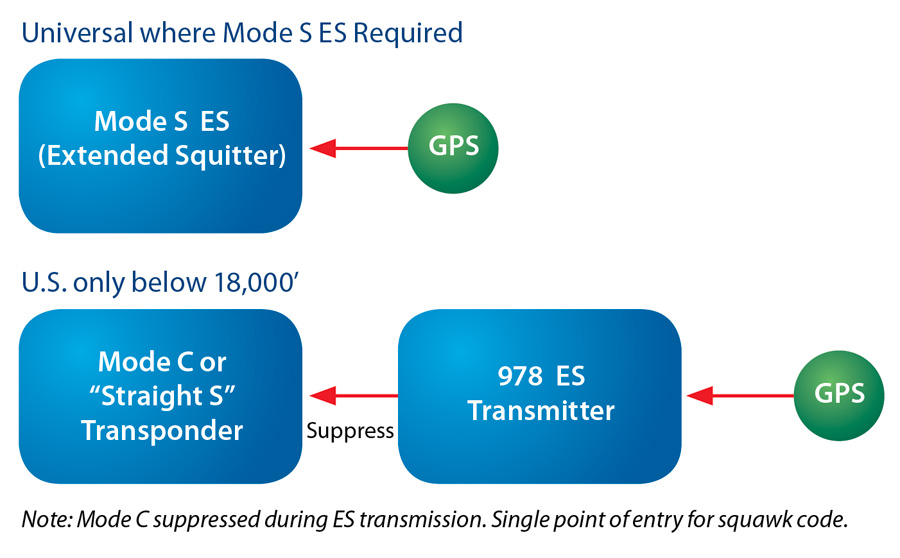
3. 1090 Mode S ES Out Paired with a 1090 ADS-B In Receiver: This configuration will receive 1090 MHz air-to-air traffic and ground station ADS-R and TIS-B transmissions. It will not receive Weather. This would be the international “gold standard.” See top of Figure 2.
4. Mode C or Straight S Transponder Paired with a 978 Transceiver for ES Out and In: U.S. only below 18,000 feet. Gets Traffic and Weather in the U.S. only. See bottom of Figure 2.
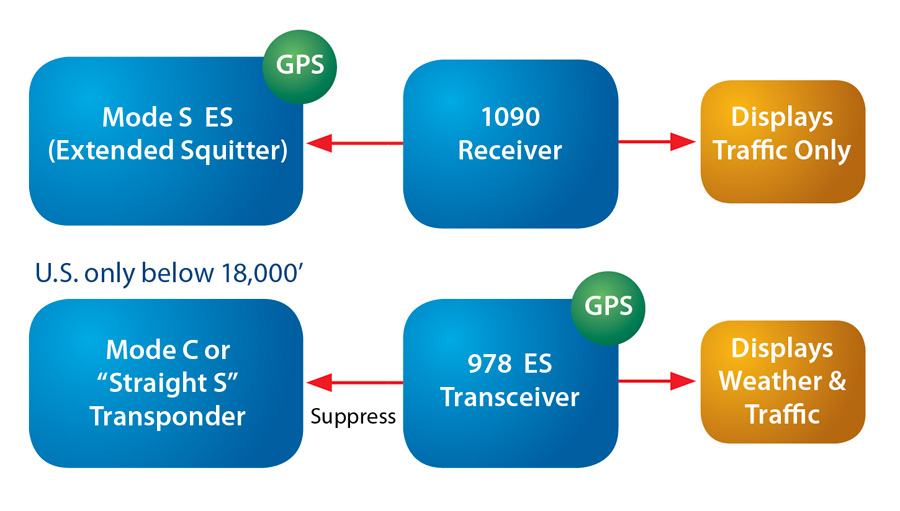
5. 1090 Mode S ES Out with 978 MHz In and 1090 MHz In: This is the U.S. “gold standard” as it will receive all air-to-air Traffic and ground station transmissions. This would also work internationally to receive traffic. See Figure 3.
For completeness the classic non-compliant configuration is shown in Figure 4. This is a common strategy while postponing the ES decision until later. This receives Weather, but Traffic may be incomplete because of the “hockey puck” issue of not being a valid client.
They maintain not. They historically have. They did on Mode C. Most likely, any delay would come in 2019 and would be selective. The “install crunch,” if it materializes, may be a major factor in any decision to delay. Because of the long lead time on this rule change, the FAA could consider that the “crunch” is self-induced by procrastination. This would make a delay less likely. At this point, you can’t bank on a delay.
Is the Installation Shop Crunch Real?
Yes and no. Yes, it will be if everyone delays until the last minute. No, it isn’t now.
The reason for going through this is certified aircraft will drive any delay. Shop availability can also be an issue with Experimentals, as owners may choose to have a shop do their install.
The FAA says there are 160,000 GA aircraft with existing transponders. They estimate 100,000 of these aircraft will be updated to ADS-B Out. They seem to be saying the remaining 60,000 will be taken out of service or only flown in non-ADS-B airspace. A little over 16,000 have been done as of the end of 2015. If there are 84,000 installs to go and four years left, that would be 21,000 per year or 1750 per month. The install rate in December 2015 was about 800 per month.
The key is the capacity of the avionics shops to install. Avionics magazine says there are 750 shops able to do this kind of work. Plainly, some specialize in certain aircraft or might not want to do ADS-B installations. I will assume 500 shops can or will do installs. The current install rate in December 2015 is therefore 1.6 installs per shop per month. If those 500 shops do the 1,750 per month required going forward, that would be 3.5 installs per shop per month. That’s certainly not a large number. However, at the other extreme, if the next three years see the current install rate of 10,000 per year, then there will be 54,000 to go in the last year. That would work out to 9.0 installs per shop per month. That seems like a large number. No one knows the avionic shop industry’s upper limit of units that can be installed per shop per month.
ADS-B installs are in addition to a shop’s normal workload. Expect shops to show preference to old or larger customers. In addition, customers often request other work to be done, extending the shop visit. Each installation is to some degree custom, depending on how unique the aircraft is and how much it has changed since it was built. Shops may be reluctant to staff up because once the install wave is past, they will be back to historic demand.
Delaying an avionics shop install or banking on an FAA delay is playing schedule chicken. You may get away with it, or you may be a statistic. Best guess is turboprops and jets will largely get done by 2020, and smaller pistons GA aircraft will be the laggards.
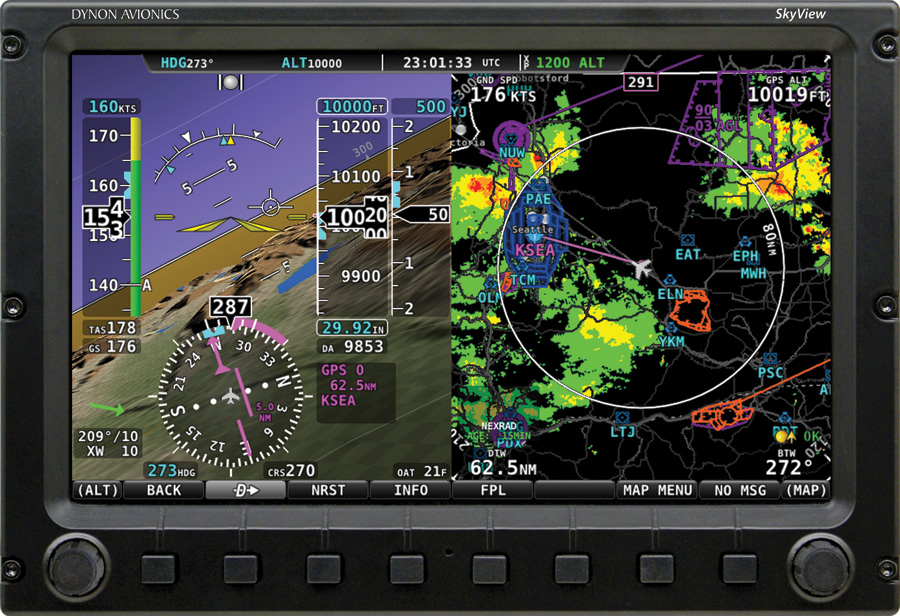
What are the Special Concerns with Experimentals?
Experimentals with sketchy as-built documentation will be challenging. A second buyer wouldn’t know the aircraft as well as the builder. Connecting or integrating different brands of equipment may be a greater challenge for the amateur. As with all aircraft, there will be issues about antenna placement, interference with/from other equipment, ground planes, composite structures, piercing pressure vessels, etc. The good news is an owner-maintained Experimental has no installation costs or install scheduling to worry about. As always with all categories, you need to get the transponder checked after installing a new one or breaking the static system. The Mode S or ES check is more complex than the Mode C check.
How Much Will it Cost?
This is the “What-will-it-cost-to-remodel-my-kitchen?” question. Well, it depends on where you are starting from, how much you do yourself vs. at a shop, what you want done, how much of a mess things are now, and integration issues.
Almost universally, TSO’d units cost more than non-TSO’d units. TSO’d units are not required for Experimentals, but they must meet the TSO specification. 1090 MHz units tend to cost more than 978 MHz units. Transmitters cost more than receivers. Installation costs of 978 MHz Out tend to cost more than 1090 MHz units because 1090 MHz units can often partially reuse legacy wiring, antennas, and trays.
The AOPA web site has a good listing of TSO’d ADS-B Out and ADS-B In hardware and prices. I do not know of a similar list for non-TSO’d equipment. Often the same manufacturers also produce non-TSO’d versions. Check their web sites.
There are a dozen or more hardware vendors playing in the ADS-B space. Some announced products may be vaporware or have no field experience. Some vendors may not survive. Check user experience when possible. Check the blogosphere for reviews. In looking at various offerings, it appears the current trend is to unbundle components so you only buy what you need. Be sure you get all the components needed for your choice by reviewing the documentation.
If you have a glass cockpit already, the first choice would be to go with units compatible with your existing glass. A best-of-breed approach brings with it integration issues.
How to Proceed and in Conclusion:
- Know your ownership time horizon and the equipped/not equipped impacts on resale value.
- Lock down your ADS-B Out mission. Where do you or the next buyer expect to fly?
- Determine your ADS-B In missions, i.e., the need for Weather and/or Traffic. They can be safety of flight issues. However, they aren’t needed by everyone.
- Avoid mission creep! Nice-to-have but unnecessary items cost money, power, time, and weight.
- Research vendor offerings for various solutions to your mission statements. Draw a detailed schematic of what you want to do.
- Talk or fly with someone knowledgeable that has installed a similar target configuration. Ask what, if anything, they would do differently.
- If using an avionics shop, review your plans with them. Know your avionics shop’s expected lead time for the planned in-service date.
- There are lots of things to juggle. Be prepared to go back to reconsider your plans when you discover “gotchas.”
- After installing ADS-B Out hardware, get your new transponder or ES check. Update your documentation, change the weight and balance if necessary, file those owner’s manuals, and change your POH while you still remember what you did.
- This is an irrational hobby for most of us. Configure to enjoy! Fly safe.



